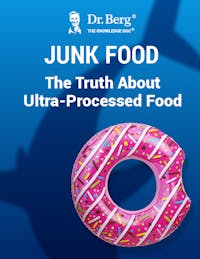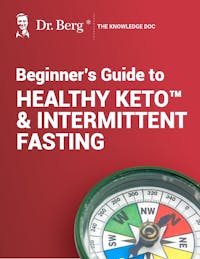Heart Races after Eating – Here’s Why

Junk Food: The Truth About Ultra-Processed Food
Learn about the detrimental impact of ultra-processed foods on health and well-being
Discover the top four dangerous hidden ingredients in everyday foods
Understand the health risks associated with consuming ultra-processed foods
Recognize misleading nutrition labels to make informed dietary choices
Get practical tips for choosing minimally processed whole foods for better health

Junk Food: The Truth About Ultra-Processed Food
Learn about the detrimental impact of ultra-processed foods on health and well-being
Discover the top four dangerous hidden ingredients in everyday foods
Understand the health risks associated with consuming ultra-processed foods
Recognize misleading nutrition labels to make informed dietary choices
Get practical tips for choosing minimally processed whole foods for better health

Junk Food: The Truth About Ultra-Processed Food
Learn about the detrimental impact of ultra-processed foods on health and well-being
Discover the top four dangerous hidden ingredients in everyday foods
Understand the health risks associated with consuming ultra-processed foods
Recognize misleading nutrition labels to make informed dietary choices
Get practical tips for choosing minimally processed whole foods for better health

Junk Food: The Truth About Ultra-Processed Food
Learn about the detrimental impact of ultra-processed foods on health and well-being
Discover the top four dangerous hidden ingredients in everyday foods
Understand the health risks associated with consuming ultra-processed foods
Recognize misleading nutrition labels to make informed dietary choices
Get practical tips for choosing minimally processed whole foods for better health

Junk Food: The Truth About Ultra-Processed Food
Learn about the detrimental impact of ultra-processed foods on health and well-being
Discover the top four dangerous hidden ingredients in everyday foods
Understand the health risks associated with consuming ultra-processed foods
Recognize misleading nutrition labels to make informed dietary choices
Get practical tips for choosing minimally processed whole foods for better health

Junk Food: The Truth About Ultra-Processed Food
Learn about the detrimental impact of ultra-processed foods on health and well-being
Discover the top four dangerous hidden ingredients in everyday foods
Understand the health risks associated with consuming ultra-processed foods
Recognize misleading nutrition labels to make informed dietary choices
Get practical tips for choosing minimally processed whole foods for better health

Junk Food: The Truth About Ultra-Processed Food
Learn about the detrimental impact of ultra-processed foods on health and well-being
Discover the top four dangerous hidden ingredients in everyday foods
Understand the health risks associated with consuming ultra-processed foods
Recognize misleading nutrition labels to make informed dietary choices
Get practical tips for choosing minimally processed whole foods for better health

Junk Food: The Truth About Ultra-Processed Food
Learn about the detrimental impact of ultra-processed foods on health and well-being
Discover the top four dangerous hidden ingredients in everyday foods
Understand the health risks associated with consuming ultra-processed foods
Recognize misleading nutrition labels to make informed dietary choices
Get practical tips for choosing minimally processed whole foods for better health

Junk Food: The Truth About Ultra-Processed Food
Learn about the detrimental impact of ultra-processed foods on health and well-being
Discover the top four dangerous hidden ingredients in everyday foods
Understand the health risks associated with consuming ultra-processed foods
Recognize misleading nutrition labels to make informed dietary choices
Get practical tips for choosing minimally processed whole foods for better health

Junk Food: The Truth About Ultra-Processed Food
Learn about the detrimental impact of ultra-processed foods on health and well-being
Discover the top four dangerous hidden ingredients in everyday foods
Understand the health risks associated with consuming ultra-processed foods
Recognize misleading nutrition labels to make informed dietary choices
Get practical tips for choosing minimally processed whole foods for better health

Junk Food: The Truth About Ultra-Processed Food
Learn about the detrimental impact of ultra-processed foods on health and well-being
Discover the top four dangerous hidden ingredients in everyday foods
Understand the health risks associated with consuming ultra-processed foods
Recognize misleading nutrition labels to make informed dietary choices
Get practical tips for choosing minimally processed whole foods for better health

Junk Food: The Truth About Ultra-Processed Food
Learn about the detrimental impact of ultra-processed foods on health and well-being
Discover the top four dangerous hidden ingredients in everyday foods
Understand the health risks associated with consuming ultra-processed foods
Recognize misleading nutrition labels to make informed dietary choices
Get practical tips for choosing minimally processed whole foods for better health

Junk Food: The Truth About Ultra-Processed Food
Learn about the detrimental impact of ultra-processed foods on health and well-being
Discover the top four dangerous hidden ingredients in everyday foods
Understand the health risks associated with consuming ultra-processed foods
Recognize misleading nutrition labels to make informed dietary choices
Get practical tips for choosing minimally processed whole foods for better health

Junk Food: The Truth About Ultra-Processed Food
Learn about the detrimental impact of ultra-processed foods on health and well-being
Discover the top four dangerous hidden ingredients in everyday foods
Understand the health risks associated with consuming ultra-processed foods
Recognize misleading nutrition labels to make informed dietary choices
Get practical tips for choosing minimally processed whole foods for better health

Junk Food: The Truth About Ultra-Processed Food
Learn about the detrimental impact of ultra-processed foods on health and well-being
Discover the top four dangerous hidden ingredients in everyday foods
Understand the health risks associated with consuming ultra-processed foods
Recognize misleading nutrition labels to make informed dietary choices
Get practical tips for choosing minimally processed whole foods for better health

Junk Food: The Truth About Ultra-Processed Food
Learn about the detrimental impact of ultra-processed foods on health and well-being
Discover the top four dangerous hidden ingredients in everyday foods
Understand the health risks associated with consuming ultra-processed foods
Recognize misleading nutrition labels to make informed dietary choices
Get practical tips for choosing minimally processed whole foods for better health

Junk Food: The Truth About Ultra-Processed Food
Learn about the detrimental impact of ultra-processed foods on health and well-being
Discover the top four dangerous hidden ingredients in everyday foods
Understand the health risks associated with consuming ultra-processed foods
Recognize misleading nutrition labels to make informed dietary choices
Get practical tips for choosing minimally processed whole foods for better health

Junk Food: The Truth About Ultra-Processed Food
Learn about the detrimental impact of ultra-processed foods on health and well-being
Discover the top four dangerous hidden ingredients in everyday foods
Understand the health risks associated with consuming ultra-processed foods
Recognize misleading nutrition labels to make informed dietary choices
Get practical tips for choosing minimally processed whole foods for better health

Junk Food: The Truth About Ultra-Processed Food
Learn about the detrimental impact of ultra-processed foods on health and well-being
Discover the top four dangerous hidden ingredients in everyday foods
Understand the health risks associated with consuming ultra-processed foods
Recognize misleading nutrition labels to make informed dietary choices
Get practical tips for choosing minimally processed whole foods for better health

Junk Food: The Truth About Ultra-Processed Food
Learn about the detrimental impact of ultra-processed foods on health and well-being
Discover the top four dangerous hidden ingredients in everyday foods
Understand the health risks associated with consuming ultra-processed foods
Recognize misleading nutrition labels to make informed dietary choices
Get practical tips for choosing minimally processed whole foods for better health

Beginner’s Guide to Healthy Keto & Intermittent Fasting
Receive a step-by-step guide to starting Healthy Keto® and intermittent fasting
Learn about foundational principles and best practices for beginners
Get detailed visual guidance on portion sizes and meal composition
Discover how to set achievable goals and monitor your progress
Find practical tips for overcoming common challenges and staying motivated

Beginner’s Guide to Healthy Keto & Intermittent Fasting
Receive a step-by-step guide to starting Healthy Keto® and intermittent fasting
Learn about foundational principles and best practices for beginners
Get detailed visual guidance on portion sizes and meal composition
Discover how to set achievable goals and monitor your progress
Find practical tips for overcoming common challenges and staying motivated

Beginner’s Guide to Healthy Keto & Intermittent Fasting
Receive a step-by-step guide to starting Healthy Keto® and intermittent fasting
Learn about foundational principles and best practices for beginners
Get detailed visual guidance on portion sizes and meal composition
Discover how to set achievable goals and monitor your progress
Find practical tips for overcoming common challenges and staying motivated

Beginner’s Guide to Healthy Keto & Intermittent Fasting
Receive a step-by-step guide to starting Healthy Keto® and intermittent fasting
Learn about foundational principles and best practices for beginners
Get detailed visual guidance on portion sizes and meal composition
Discover how to set achievable goals and monitor your progress
Find practical tips for overcoming common challenges and staying motivated

Beginner’s Guide to Healthy Keto & Intermittent Fasting
Receive a step-by-step guide to starting Healthy Keto® and intermittent fasting
Learn about foundational principles and best practices for beginners
Get detailed visual guidance on portion sizes and meal composition
Discover how to set achievable goals and monitor your progress
Find practical tips for overcoming common challenges and staying motivated

Beginner’s Guide to Healthy Keto & Intermittent Fasting
Receive a step-by-step guide to starting Healthy Keto® and intermittent fasting
Learn about foundational principles and best practices for beginners
Get detailed visual guidance on portion sizes and meal composition
Discover how to set achievable goals and monitor your progress
Find practical tips for overcoming common challenges and staying motivated

Beginner’s Guide to Healthy Keto & Intermittent Fasting
Receive a step-by-step guide to starting Healthy Keto® and intermittent fasting
Learn about foundational principles and best practices for beginners
Get detailed visual guidance on portion sizes and meal composition
Discover how to set achievable goals and monitor your progress
Find practical tips for overcoming common challenges and staying motivated

Beginner’s Guide to Healthy Keto & Intermittent Fasting
Receive a step-by-step guide to starting Healthy Keto® and intermittent fasting
Learn about foundational principles and best practices for beginners
Get detailed visual guidance on portion sizes and meal composition
Discover how to set achievable goals and monitor your progress
Find practical tips for overcoming common challenges and staying motivated

Beginner’s Guide to Healthy Keto & Intermittent Fasting
Receive a step-by-step guide to starting Healthy Keto® and intermittent fasting
Learn about foundational principles and best practices for beginners
Get detailed visual guidance on portion sizes and meal composition
Discover how to set achievable goals and monitor your progress
Find practical tips for overcoming common challenges and staying motivated

Beginner’s Guide to Healthy Keto & Intermittent Fasting
Receive a step-by-step guide to starting Healthy Keto® and intermittent fasting
Learn about foundational principles and best practices for beginners
Get detailed visual guidance on portion sizes and meal composition
Discover how to set achievable goals and monitor your progress
Find practical tips for overcoming common challenges and staying motivated

Beginner’s Guide to Healthy Keto & Intermittent Fasting
Receive a step-by-step guide to starting Healthy Keto® and intermittent fasting
Learn about foundational principles and best practices for beginners
Get detailed visual guidance on portion sizes and meal composition
Discover how to set achievable goals and monitor your progress
Find practical tips for overcoming common challenges and staying motivated

Beginner’s Guide to Healthy Keto & Intermittent Fasting
Receive a step-by-step guide to starting Healthy Keto® and intermittent fasting
Learn about foundational principles and best practices for beginners
Get detailed visual guidance on portion sizes and meal composition
Discover how to set achievable goals and monitor your progress
Find practical tips for overcoming common challenges and staying motivated

Beginner’s Guide to Healthy Keto & Intermittent Fasting
Receive a step-by-step guide to starting Healthy Keto® and intermittent fasting
Learn about foundational principles and best practices for beginners
Get detailed visual guidance on portion sizes and meal composition
Discover how to set achievable goals and monitor your progress
Find practical tips for overcoming common challenges and staying motivated

Beginner’s Guide to Healthy Keto & Intermittent Fasting
Receive a step-by-step guide to starting Healthy Keto® and intermittent fasting
Learn about foundational principles and best practices for beginners
Get detailed visual guidance on portion sizes and meal composition
Discover how to set achievable goals and monitor your progress
Find practical tips for overcoming common challenges and staying motivated

Beginner’s Guide to Healthy Keto & Intermittent Fasting
Receive a step-by-step guide to starting Healthy Keto® and intermittent fasting
Learn about foundational principles and best practices for beginners
Get detailed visual guidance on portion sizes and meal composition
Discover how to set achievable goals and monitor your progress
Find practical tips for overcoming common challenges and staying motivated

Beginner’s Guide to Healthy Keto & Intermittent Fasting
Receive a step-by-step guide to starting Healthy Keto® and intermittent fasting
Learn about foundational principles and best practices for beginners
Get detailed visual guidance on portion sizes and meal composition
Discover how to set achievable goals and monitor your progress
Find practical tips for overcoming common challenges and staying motivated

Beginner’s Guide to Healthy Keto & Intermittent Fasting
Receive a step-by-step guide to starting Healthy Keto® and intermittent fasting
Learn about foundational principles and best practices for beginners
Get detailed visual guidance on portion sizes and meal composition
Discover how to set achievable goals and monitor your progress
Find practical tips for overcoming common challenges and staying motivated

Beginner’s Guide to Healthy Keto & Intermittent Fasting
Receive a step-by-step guide to starting Healthy Keto® and intermittent fasting
Learn about foundational principles and best practices for beginners
Get detailed visual guidance on portion sizes and meal composition
Discover how to set achievable goals and monitor your progress
Find practical tips for overcoming common challenges and staying motivated

Beginner’s Guide to Healthy Keto & Intermittent Fasting
Receive a step-by-step guide to starting Healthy Keto® and intermittent fasting
Learn about foundational principles and best practices for beginners
Get detailed visual guidance on portion sizes and meal composition
Discover how to set achievable goals and monitor your progress
Find practical tips for overcoming common challenges and staying motivated
Noticing that your heart races after eating could be a sign of poor gallbladder function, electrolyte imbalance, low blood sugar, or excessive caffeine or alcohol intake.
Learn what can trigger heart palpitations after eating and discover natural remedies to manage and prevent food-related arrhythmia.

What are heart palpitations?
Heart palpitations, also known as arrhythmia, are characterized by an irregular heart rhythm that typically manifests as a fluttering, pounding, or throbbing sensation in the chest and neck area.
Heartbeats are regulated by a complex interplay between the autonomic nervous system and muscle fibers and are governed by the sinoatrial node, which is the heart's natural pacemaker.
Factors including elevated blood pressure, stress, anxiety, changes in body temperature, elevated blood pH levels, potassium deficiency, and hormonal imbalances can disrupt the communication between the nervous system and heart muscles and result in an irregular heartbeat.
In addition, certain gastrointestinal conditions and consuming meals high in refined carbs and sugars can raise an individual's heart rate after eating.
Heart palpitations, especially food-related, are generally not a serious issue and can typically be managed by making beneficial dietary and lifestyle changes and addressing potential underlying medical conditions.
Watch the video below to discover what may cause abnormal heart rhythms after eating.
Why Do You Get Heart Palpitations After Eating?
Possible reasons your heart races after eating
Experiencing heart pounding after eating is not uncommon, and research published in the Journal of Clinical Neurology confirms that food intake is a common trigger of arrhythmia.
Here are four possible reasons for heart palpitations after eating.
1. Certain foods and beverages
It’s well known that certain foods and beverages can stimulate the autonomic nervous system, which can trigger heart palpitations in sensitive individuals.
Here are common foods associated with arrhythmia:
High sodium foods
Processed foods
Spicy foods
Foods seasoned with monosodium glutamate
Alcohol consumption and excessive caffeine intake from coffee, energy drinks, or sports drinks can also interfere with nerve signal transmission and heart rate regulation.
In addition, a high-carb diet has been associated with an increased risk of arrhythmia after eating.
“Regularly consuming carbohydrates and sugars can cause blood sugar fluctuations, which activate the body’s stress response,” explains Dr. Berg. “This triggers the release of stress hormones such as cortisol and epinephrine linked to an increased heart rate.”
2. Electrolyte imbalances
Electrolytes such as sodium and potassium play a critical role in heart rate regulation by influencing cardiac cell function, essential for maintaining the heart's rhythmic contractions.
Evidence published in Circulation Research suggests that potassium deficiency, also known as hypokalemia, is a common electrolyte imbalance that can negatively impact heart health and cause palpitations.

3. Poor digestive health
It appears that individuals with gastrointestinal problems such as acid reflux, gastroesophageal reflux disease (GERD), and sluggish gallbladder function are at increased risk of a racing heart after eating.
Digestive processes activate the vagus nerve, a major nerve regulating various physiological functions, including heart rate.
Poor digestive health and intestinal inflammation due to blocked bile ducts, acid reflux, or delayed stomach emptying can overstimulate the vagus nerve and lead to heartbeat fluctuations after eating a meal.
4. Alkaline pH
Elevated blood pH levels, also known as alkalosis, can develop due to potassium deficiency, dehydration, antacid use, diuretics, hormonal imbalances, and kidney disease.
Alkalosis interferes with heart rate regulation by disrupting the balance of sodium and potassium ions inside and outside of cardiac cells, which can lead to arrhythmias.

Heart palpitation remedies
The best remedy for a racing heart after eating depends on the underlying cause and typically involves making beneficial dietary and lifestyle changes.
Here are five steps you can take to manage food-related heart palpitations.
1. Practice intermittent fasting
Intermittent fasting is a mealtime schedule that alternates between fasting periods and time-restricted periods of eating.
Caloric restriction during fasting allows the digestive system to rest as it isn’t constantly required to process and digest foods. This may be especially important for individuals with palpitations due to intestinal issues such as GERD, acid reflux, or poor gallbladder function.
Intermittent fasting can reduce excessive stomach acid linked to reflux symptoms and allows the gallbladder to rest, which may improve gallbladder function and promote overall digestive health.
In addition, evidence published in Neuroscience suggests that fasting allows the digestive system to regenerate and has beneficial effects on vagus nerve function, which plays a critical role in regulating heart rate and rhythm.
2. Avoid a high-carb diet
Consuming processed sugars and carbohydrates can cause blood sugar fluctuations linked to heart palpitations.
Consuming a nutritious low-carb diet such as Healthy Keto® promotes steady blood sugar levels, thereby lowering the risk of a pounding heart after eating.
Healthy Keto focuses on non-GMO organic produce, healthy fats, grass-fed beef, wild-caught fish and game meat, pasture-raised eggs, and organic full-fat dairy products.
This meal pattern not only provides ample nutrients and promotes electrolyte balance crucial for heartbeat regulation but is also linked to a lower risk of GERD and acid reflux.
A study published in The American Journal of Gastroenterology found that restricting carbohydrates can improve acid reflux symptoms in individuals diagnosed with GERD.

3. Increase potassium intake
Potassium is the most important electrolyte needed for the signal transmission of cardiac cells. Maintaining optimal potassium levels supports cardiovascular health and plays a critical role in preventing irregular heartbeats.
Unfortunately, many people don’t consume the recommended daily potassium intake of 4,700 milligrams, leaving many potassium deficient and at an increased risk of palpitations.
Consuming plenty of potassium-rich foods such as beet tops, avocados, lima beans, spinach, and salmon helps promote electrolyte balance and supports a healthy heartbeat.
However, it can be challenging to obtain the body’s potassium requirements through diet alone, and taking a sugar-free electrolyte powder containing at least 1,000 milligrams of potassium is an excellent way to maintain electrolyte balance.
4. Keep a food diary
Sensitive individuals may experience heart palpitations after consuming specific foods or beverages, such as salty or spicy foods, energy drinks, or coffee.
Keeping a food diary is an excellent strategy to identify palpitation-triggering foods that should be avoided.
5. Practice stress reduction techniques
Stress activates the vagus nerve and triggers the release of stress hormones linked to palpitations.
Engaging in stress-reduction techniques such as deep breathing, walking in nature, gardening, and spending time with friends and family can counteract the negative effects of everyday stress and may reduce irregular heartbeats.
In addition, increasing your intake of stress-relieving vitamins and taking adaptogenic herbs such as ashwagandha support the body’s stress resilience and can help lower the risk of palpitations.

When to see a doctor
Most cases of a racing heart after eating are harmless and can be managed with dietary and lifestyle modifications.
However, in some instances, palpitations can be a sign of more serious health problems, such as atrial fibrillation or coronary artery disease, which can impact blood flow and oxygen transport.
If you are experiencing persistent periods of palpitations accompanied by high blood pressure, chest pain, difficulty breathing, dizziness, or fainting, it’s crucial to seek immediate medical attention for a thorough evaluation of your symptoms.

Key takeaways
Food-related heart palpitations are common and often linked to poor digestive health, stress, a high-carb diet, and electrolyte imbalances.
If your heart races after eating, you may benefit from practicing intermittent fasting, following a nutritious, low-carb diet like Healthy Keto, and maintaining adequate potassium intake.
However, persistent palpitations can indicate heart disease, and it’s crucial to seek medical attention immediately if a racing heartbeat is accompanied by breathing difficulties, fainting, or chest pain.
FAQ
1. Why does my heart beat so fast after I eat?
Consuming sugars and carbohydrates, spicy foods, and processed foods with a high sodium content can trigger food-related palpitations.
In addition, individuals with underlying digestive issues such as acid reflux, poor gallbladder function, and gastroesophageal reflux disease (GERD) appear at an increased risk of a racing heart after eating.
2. What foods should you avoid if you have heart palpitations?
To manage or prevent irregular heartbeats after eating, it’s recommended to limit sodium-rich and spicy foods and avoid consuming carbohydrates and sugars, which can cause blood sugar fluctuations linked to palpitations.
In addition, alcohol and caffeinated beverages such as coffee, tea, soda, energy drinks, and sports drinks are common triggers of a racing heartbeat.
3. How do I stop my heart from racing after a meal?
Avoiding trigger foods is crucial to managing palpitations. In addition, practicing intermittent fasting and following a low-carb diet promotes heart health and can reduce the risk of food-related blood sugar fluctuations and palpitations.
Potassium plays a critical role in heartbeat regulation, and maintaining adequate potassium intake by consuming plenty of potassium-rich foods or using a high-potassium electrolyte powder is an excellent strategy to promote a steady heartbeat.
4. Is it normal that my heart races after eating?
A racing heart after eating is common and often linked to alcohol, caffeinated beverages, spicy food, sugars, and carbohydrates.
5. When should I be concerned about heart palpitations after eating?
You should be concerned about heart palpitations after eating if they’re accompanied by chest pain, shortness of breath, dizziness, or fainting, as these could indicate a potentially serious underlying heart condition.
Sources
Previous blog
Why Are French Fries So AddictiveNext blog
Are Carrots Keto-Friendly?Tags

Popular
08/21/2024
55K views
02/23/2025
46.3K views
11/18/2024
277.5K views
03/18/2024
11/21/2022




